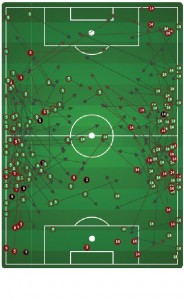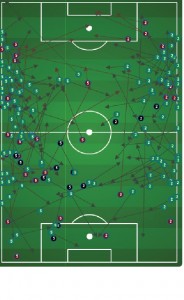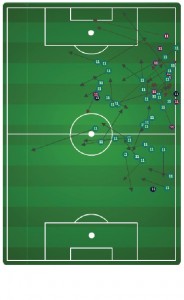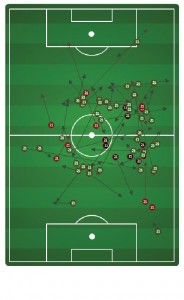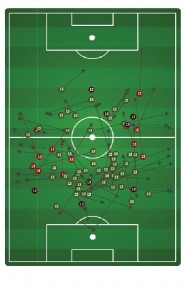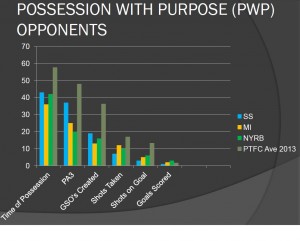Cascadia Cup Clash – Timbers Player Evaluations

An interesting side offered up by Caleb Porter in his inaugural Cascadia Cup clash – not quite what we saw at home against New York or Montreal but just as effective when looking at the final result in comparison to the game against New York.
So what was different and why and how did it impact player activities and their subsequent evaluations?
In the first two games we saw Portland trot out with three Forwards playing a variety of rotational roles with Diego Valeri leading the attack from his midfield position.
In this, the first away game for Portland, Porter pulled Kalif Alhassan from the starting 11 and injected Jack Jewsbury (the wizened veteran) in a Central Defensive Midfield role to try and create a more connected back-four that would stop the goal-rot seen in the first two games.
Part of this strategy also included a more cautious approach by the fullbacks as they pushed higher up the pitch. For example; here’s the OPTA graph for Zemanski and Harrington this game versus the OPTA graph for Miller and Harrington in the Montreal game.
With these OPTA charts offered my Player Evaluations begin.
While it may be difficult to see, without taking a minute or two, there is more defensive activity in the defending half of the pitch for Harrington and Zemanski in the Sounders match than that of Harrington and Miller in the New York match.
For me this speaks to a less aggressive (more patient) build up from the back four (keeping them tighter and more cohesive) throughout the overall context of the game in comparison to both players bombing up the pitch at the earliest opportunity.
Ben Zemanski:
Ben was asked to take over the right fullback position in this critical game (grit was a word used by Porter) and given the overall distribution and defensive stature he did what was asked; some might say a touch better?.
For me, not with respect to the general run of play though. 59% of the penetrations generated by Seattle took place down his wing and yes Zemanski could have played a touch deeper during the transition in attack with Chara
Fair dues – but if you scroll down to the Chara OPTA distribution it’s quite surprising to see how little Chara needed to do to support Zemanski in this highly traveled area.
And great credit should go to Ben for minimizing this obnoxious overload in attack by Seattle.
Final Grade B:
Michael Harrington:
Like Ben, Michael appeared to have been asked to pull back a wee bit on the throttle this game and conserve a more defensive posture for the full 90 minutes.
Again, well played this game and his balance on a pretty inactive side may have had just as much to do with Seattle channeling down the Portland right side as opposed to just the mere presence of Zakuani over there.
More to follow as the next game unfolds against Seattle.
Final Grade B.
Diego Chara:
In seeing this minor difference in structure as well as the replacement of Jewsbury for Alhassan (their two OPTA snaps are provided below); the overall tenor of this game from kickoff was ‘defense first’…
- Alhassan vs NYRB
Note the positional difference in having Alhassan on the pitch in a wide right forward role as opposed to the more central right sided role provided by Chara; seen in the picture below.
So although Diego basically replaced Alhassan on the right he did not take on the more forward role; his play was more central and more defensive in nature.
A reminder about Zemanski – note the minimal activity by Chara down deep in the defending third…
Given that slightly different role in ‘thinking defense first’ Diego again played well and completed the game without a Yellow card; I’ll have to check some records on Diego but his discipline appears to have gotten significantly better in measuring the strength and placement of his tackles.
Yellow cards in the defending half lead to set-pieces and set-pieces win games; the fewer received the better…
No doubt everyone knows that if given the chance to play that ball again Diego would have played it more forward as opposed to backwards… as he gains experience in playing a bit wider he should get better at leading Zemanski.
Final Grade: C.
Jack Jewsbury:
Jack was pulled into the side (like Zemanski) to add ‘grit’ and no doubt an additional veteran presence in the center of midfield. There was much activity on his selection (pros and cons) and expectations on his performance varied before game time varied.
Tough call this but here’s the bottom line for me…
Jack was brought in to anchor the front of the back-four; he confirmed that in an interview today.
When viewing OPTA on his defensive presence here’s what how things played out.
Clearly he came on the pitch and worked in the area assigned; time will tell on how well he and Johnson and Chara meld but when thinking and playing defense first; while Portland STILL gets as much attacking presence as they did against Seattle there is no appreciable loss with Jack on the pitch and Alhassan off.
As a reminder; the overall attacking statistics for this game were not much different in comparison to the game against New York.
Portland had slightly less possession this game but exceeded PA3 and matched GSO’s for the game against New York.
The real tell comes down to what defense was stronger, Seattle or New York – clearly Seattle had the edge given the reduced shots taken and reduced shots on goal versus Seattle.
And here’s the reminder of the PWP of Seattle and other opponents to compare ‘defense’ considerations…
And when considering that Alhassan was on the pitch against New York and Jewsbury was on the pitch against Seattle PTFC also had fewer shots taken, fewer shots on goal and fewer goals against.
Clearly the back-four, along with the inclusion of Jewsbury made this team better in defense.
Final Grade: B.
Mikael Silvestre:
Getting his legs and bearing and positional awareness locked in shows how effective Silvestre is becoming playing center-back for Portland. While Baptiste made a school-kid error of not tracking Johnson over his right shoulder, on that goal, Silvestre did a great job of following his player as he moved to the near post.
Center-backs, however, work in pairs and it wasn’t clear what level of communication did or didn’t take place with Baptiste. If there was communication from Silvestre to Baptiste during that crossover by the Sounders strikers than kudo’s to Mikael for calling it out.
If Silvestre was slow on the mark to notice Johnson running off Baptiste’s right shoulder than Silvestre needs to be more active in his leadership role.
Without knowing either way it’s not reasonable to offer how that might impact his evaluation.
Final Grade: B. (if leadership provided) C. (if not).
AJ Baptiste:
The learning curve and Baptism by fire for Baptiste continues… by mid-season his notebook on lessons learned should be near full… Hopefully those mistakes that happen aren’t repetitive.
It’s a hard slog playing center-back, one of the toughest positions in soccer. Great kudo’s for the deft touch with the chest to the pitch and on with the looping cross to the near post – brilliant – and not something to expect as routine for a big center-back!
Conversely AJ needs to get eyes in the sides and back of his head and needs to tell Ricketts and Silvestre to give him better assistance if they aren’t already – part of leadership is following; the greatest leaders are the greatest followers.
Two events don’t make a game but there were compelling events in an aggressive match played in Seattle; a huge game for a young player like Baptiste; good job and solid play for 89 minutes and 50 seconds….
Final Grade: C.
Donovan Ricketts:
Not much activity for Donovan this game and that’s a great credit to a more engaged back-four that didn’t play like a ‘last-four’. Three shots on goal and absolutely no real chance to save the sitter by Johnson at the 12 minute mark.
The less activity for Donovan the better; not because he’s not good at making saves – because it means the back-four and midfield support to the back-four is getting better.
As with Silvestre, it’s unclear whether or not the opportunity presented itself to alert Baptiste that Johnson was moving to the far post off his right shoulder…
Final Grade: B (if leadership provided to Baptiste). C (if not).
Will Johnson:
A complicated game for Will on Saturday; the majority of action was on the opposite side of the pitch to him and he played more of a left midfield box to box (like Chara) than his previous matches in running the middle.
It’s not clear (like it wasn’t for Harrington) whether or not Seattle focused more on their left on purpose or if Seattle ended up being there becuase Harrington and Johnson did such a great job of shutting Seattle down on our left.
All told though a great adjustment in this new scheme and perhaps one we will see more of as the season progresses. There remains value and benefit in playing 2 box-to-box midfielders side by side when running another in front of the back and Valeri up top (center – left – right) as the flow of the game changes.
He did his absolute best to squeeze back and pick up Zakuani – valient effort and it’s just one of those things that happens.
In considering his link with Nagbe it’s not clear how many times either of them targeted each other but for the better part of the game quite a bit of build-up came down the left wing and combining with Harrington and Nagbe had much to do with many GSO’s created in the first half.
Final Grade: B
Diego Valeri:
NBC Sports advocated Valeri was going to play and high and wide left side forward this game and he pretty much ignored that offering.
To be clear, Valeri was again, at home, playing the central midfield attacking role – evidence below.
If he were truly playing a left forward attacker his distribution, possession, etc would fill up the top left quadrant… no such thing.
So with three games come and gone one thing is obvious, Valeri has the responsibility to manage the attack up top.
Alonso did a great job against Valeri and that’s two central midfielders (Alonso and Bernier) who have done a good job bottling him up.
What’s needed is greater communication and chemistry (as the season unfolds) with Nagbe, Johnson, Piq and others. The more time for this relationship the greater the understanding in how to maximize space and create space.
To be honest Valeri was unlucky on one set-piece and I’m surprised he tries to drive home others at lower angles (through the wall) as opposed to going around and atop the wall.
He has touch and he can bend it, not like Beckham, but as the set-piece specialist his B game becomes an A game with goals scored and not near misses.
He had five shots, three off target and one blocked… 20% on target needs to get better; Valeri knows that.
Final Grade: C
Darlington Nagbe:
Strong game by Darlington and he continues to build a relationship with Valeri and Johnson up top while linking well with Harrington and Will Johnson.
On a number of occasions Darlington dropped into the defending half to create space and try to free up Valeri; this was somewhat successful at times but with the wider and longer pitch it still made it difficult to link effectively without taking on some dribble drives at times.
His most effective play came when he drove a bit deep in the corner and then worked for a pass into the top of the 18 yard box; all good but just lacked the finishing touch needed to get a goal.
A bit harsh perhaps but a wider and longer pitch should suit Darlington’s style a bit better than the cramped conditions at JELD-WEN; perhaps we see a far more productive Nagbe/Valeri pairing on a larger pitch as the season unfolds?
Final Grade C.
Ryan Johnson:
Ryan continues to play multiple roles up top; target forward as well as one who rotates and works off others.
As for his participation and rotation across the pitch against Seattle; he had good movement left, right, up and back but through all that activity his finishing touches on passing and linking with others lacked somewhat.
Much of that had to do with the tighter defense Seattle played in comparison to New York. Perhaps the most compelling tale in this game was Ryan’s inability to get off a shot from any location.
That being said, both he and Piq did perform their role well in occupying the center-backs as Wallace jumped in to score the equalizer; so again it’s not just about scoring goals, it’s about all the other things that go with that.
Final Grade C.
Jose Valencia:
Jose had virtually little time to impact this game and there simply was no activity to speak of in OPTA to confirm he played.
Of course my notes indicate he came on in added time so all’s fair – no real time to impact the game so no real time to offer a grade relative to his performance.
Final Grade: Not Scored.
Frederic Piquionne:
Piq came on for Jewsbury in the 70 minute mark.
For awhile he combined with Johnson to create a different attacking look as the game clock wound down. Not bad this move and with both Johnson and Piq up top it was clear that their presence in occupying the center-backs leading up to Wallace’s goal had a major role in that score.
Others may feel differently but this look gives Portland two big forwards to target on either side of the pitch as the midfielders look to play off them. It adds a direct attacking option to the squad as the game minutes slide away.
All good in my book as it enhances variation. Not much to offer up other than the space making for Wallace but since that was the tying goal it’s a pretty good thing for the result.
Final Grade C.
Rodney Wallace:
A few folks have offered differing thoughts on Rodney over the last year or two; and I have one I’m pretty comfortable with.
Rodney brings athleticism and a good head to this game in just being at the right place at the right time. This sensing is hard to quantify at times but it was his toe-poke that freed up Nagbe resulting in a goal against New York.
And it was his well placed location and timely leap that got Portland the equalizer in Seattle. This 1 point is HUGE for Portland, if not inordinately large. All credit needs to go his way for sensing the right location at the right time.
Of note is that when Wallace came on for Harrington he had virtually no heat index in the defending half of the pitch; clearly with 10 minutes to go Porter slid into a 3 back formation… two solid tactical moves with one substitution; it’s that type of change that was missing from the Timbers last year.
Bottom line here Rodney came on – did exactly what was required and got the job done!
Final Grade: A.
In closing…
I liked the side offered up by Porter and can see that sort of formation/system/style beginning to take shape a bit more if productivity (time of possession, penetrations into the attacking third and creating goal scoring opportunities remains high).
What might have been considered a ‘stretch target’ for this year is almost becoming the norm; a bit scary really.
If / when this team goes up one goal what might we expect as teams look to get that equalizer?
Defense must remain first if this team is going to succeed… this away game in the den of the enemy was a great example – hopefully it’s not a one-off!
Team notes…
Hanyer Mosquera has returned to Colombia for the time being; no injury and no other compelling issues going on – simply stated ‘some time away’.
Horst continues to work on getting his full fitness back while Altman remains on trial and Meves remains in camp training with the team.
Next up for me is some research on Colorado; we got them three times this year with this being the lone away game against them.
You can follow me on twitter here

